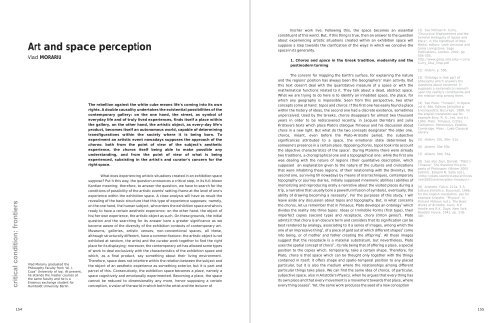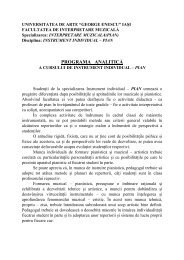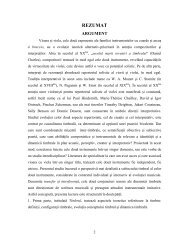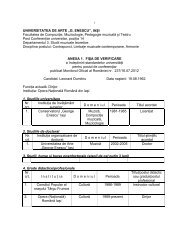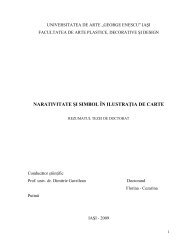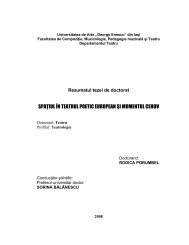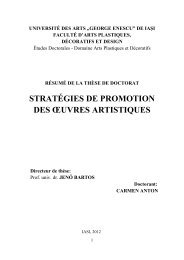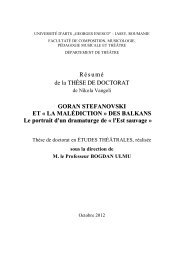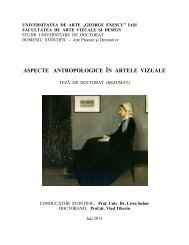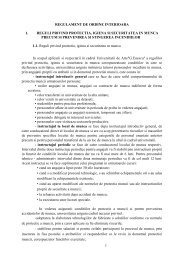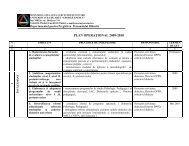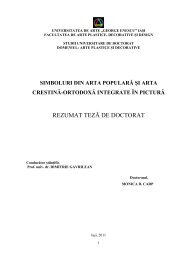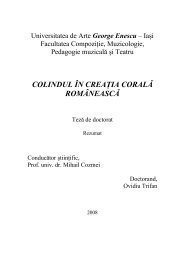vector 2_1.cdr - Universitatea de Arte "George Enescu"
vector 2_1.cdr - Universitatea de Arte "George Enescu"
vector 2_1.cdr - Universitatea de Arte "George Enescu"
Create successful ePaper yourself
Turn your PDF publications into a flip-book with our unique Google optimized e-Paper software.
critical condition: frontiers<br />
154<br />
Art and space perception<br />
Vlad MORARIU<br />
Vlad Morariu graduated the<br />
Philosophy Faculty from “Al. I.<br />
Cuza” University of Iaşi. At present,<br />
he attends the master courses at<br />
the same faculty and he is a<br />
Erasmus exchange stu<strong>de</strong>nt for<br />
Humboldt University Berlin.<br />
The rebellion against the white cube means life's coming into its own<br />
rights. A double causality un<strong>de</strong>rtakes the existential possibilities of the<br />
contemporary gallery: on the one hand, the street, as symbol of<br />
everyday life and of truly lived experiences, finds itself a place within<br />
the gallery, on the other hand, the artistic object, as every-day life's<br />
product, becomes itself an autonomous world, capable of <strong>de</strong>termining<br />
transfigurations within the society where it is being born. To<br />
experiment an artistic event nowadays supposes the approach of the<br />
choros: both from the point of view of the subject's aesthetic<br />
experience, the choros itself being able to make possible any<br />
un<strong>de</strong>rstanding, and from the point of view of what is being<br />
experienced, subsisting in the artist's and curator's concern for the<br />
right space.<br />
What does experiencing artistic situations created in an exhibition space<br />
suppose? Put it this way, the question announces a critical step, in its full-blown<br />
Kantian meaning; therefore, to answer the question, we have to search for the<br />
conditions of possibility of the artistic events' setting-frame at the level of one's<br />
experience within the exhibition space. A close analysis will have as result the<br />
revealing of the basic structure that this type of experience supposes; namely,<br />
on the one hand, the human subject, who enters the exhibition space and who is<br />
ready to have a certain aesthetic experience; on the other hand, the object of<br />
his/her own experience, the artistic object as such. On these grounds, the initial<br />
question and the searching for its answer bare a greater significance as we<br />
become aware of the diversity of the exhibition contexts of contemporary art.<br />
Museums, galleries, artistic venues, non-conventional spaces, all these,<br />
although structurally different, have a common feature: the artistic object is not<br />
exhibited at random, the artist and the curator work together to find the right<br />
place for its displaying; moreover, the contemporary art has allowed some types<br />
of work to <strong>de</strong>al exclusively with the characteristics of the exhibition space and<br />
which, as a final product, say something about their living environment.<br />
Therefore, space does not interfere within the relation between the subject and<br />
the object of an aesthetic experience as something exterior, but it is part and<br />
parcel of this. Consecutively, the exhibition space becomes a place, namely a<br />
space cognitively and emotionally experimented. Becoming a place, the space<br />
cannot be reduced to dimensionality any more, hence supposing a certain<br />
conception, a vision of the world in which both the artist and the lecturer of<br />
his/her work live. Following this, the space becomes an essential<br />
constituent of this world. But, if this thing is true, then an answer to the question<br />
about experiencing artistic situations created within an exhibition space will<br />
suppose a step towards the clarification of the ways in which we conceive the<br />
space in its generality.<br />
1. Choros and space in the Greek tradition, mo<strong>de</strong>rnity and the<br />
postmo<strong>de</strong>rn turning<br />
The concern for mapping the Earth's surface, for explaining the nature<br />
and the regions' position has always been the Geographers' main activity. But<br />
this text doesn't <strong>de</strong>al with the quantitative measure of a space or with the<br />
mathematical functions related to it. They talk about a <strong>de</strong>ad, abstract space.<br />
What we are trying to do here is to i<strong>de</strong>ntify an inhabited space, the place, for<br />
which any geography is impossible. Seen from this perspective, two other<br />
concepts come at hand: topos and choros. If the first one has easily found a place<br />
within the history of i<strong>de</strong>as, the second one had a discrete existence, sometimes<br />
unperceived. Used by the Greeks, choros disappears for almost two thousand<br />
years in or<strong>de</strong>r to be rediscovered recently, in Jacques Derrida's and Julia<br />
Kristeva's texts which place Plato's dialogue Timaeus and his discussion about<br />
chora in a new light. But what do the two concepts <strong>de</strong>signate? The ol<strong>de</strong>r one,<br />
choros, meant, even before the Plato-Aristotle period, the subjective<br />
significances attributed to a space, the emotional state <strong>de</strong>termined by<br />
someone's presence in a certain place. Opposing choros, topos took into account<br />
1<br />
the objective characteristics of the space . During Ptolemy there were already<br />
two traditions, a chorographical one and a topographical one: while the first one<br />
was <strong>de</strong>aling with the nature of regions (their qualitative <strong>de</strong>scription, which<br />
supposed an explanation given to the nature of the cultures and civilizations<br />
that were inhabiting these regions, of their relationship with the Divinity), the<br />
second one, surviving till nowadays by means of oral techniques, contemporary<br />
topography or journey diaries, initially supposed mnemonic abilities (abilities of<br />
memorizing and reproducing orally a narrative about the visited places during a<br />
trip, a narrative that usually bore a powerful infusion of symbols), eventually, the<br />
2<br />
ability of drawing becoming a necessity . For the purposes of this study, I will<br />
leave asi<strong>de</strong> any discussion about topos and topography. But, in what concerns<br />
3<br />
the choros, let us remember that in Timaeus, Plato <strong>de</strong>velops an ontology which<br />
divi<strong>de</strong>s the reality into three types: I<strong>de</strong>as or Immobile Forms (first type), their<br />
4<br />
imperfect copies (second type) and receptacle, chora (triton genos ). Plato<br />
admits it that chora is an obscure term and consi<strong>de</strong>rs that its signification can be<br />
best ren<strong>de</strong>red by analogy, associating to it a series of images, among which the<br />
5 6<br />
one of an impressive thing , of a piece of gold out of which different shapes come<br />
7<br />
into being, or of mother and father creating the offspring . All these images<br />
suggest that the receptacle is a material substratum, but nevertheless, Plato<br />
8<br />
uses the spatial concept of chora , its role being that of offering a place, a special<br />
position to the copies which, temporarily, take a certain shape. Therefore, for<br />
Plato, chora is that space which can be thought only together with the things<br />
contained in itself; it offers shape and spatio-temporal position to any placed<br />
particular, but it is also the medium where the relationships among different<br />
particular things take place. We can find the same i<strong>de</strong>a of choros, of particular,<br />
subjective space, also in Aristotle's Physics, when he argues that every thing has<br />
its own place and that every movement is a movement towards that place, where<br />
9<br />
every thing ceases . Yet, the same work produces the seed of a new conception<br />
[1] See Michael R. Curry,<br />
“Discursive Displacement and the<br />
Seminal Ambiguity of Space and<br />
Place”, in The Handbook of New<br />
Media, editors: Leah Lievrouw and<br />
Sonia Livingstone, Sage<br />
Publications, London, 2002, pp.<br />
504-505,<br />
http://www.geog.ucla.edu/~curry/<br />
Curry_Disc_Disp.pdf<br />
[2] ibi<strong>de</strong>m, p. 506.<br />
[3] Ontology is that part of<br />
philosophy which answers the<br />
questions about existence. It<br />
supposes a systematical research<br />
upon the reality's constituents and<br />
the relation-ship among them.<br />
[4] See Plato, “Timaios”, in Opere,<br />
vol.6, 48e, Editura Ştiinţifică şi<br />
Enciclopedică, Bucureşti, 1989; for<br />
the english translation see for<br />
example Bury, R. G., (ed. and tr.),<br />
1960, Plato: Timaeus, Critias,<br />
Cleitophon, Menexenus, Epistles,<br />
Cambridge, Mass.: Loeb Classical<br />
Library.<br />
[5] ibi<strong>de</strong>m, 50c, 50e- 51a.<br />
[6] ibi<strong>de</strong>m, 50a-50b.<br />
[7] ibi<strong>de</strong>m, 50d, 51a.<br />
[8] See also Zeyl, Donald, “Plato's<br />
Timaeus”, The Stanford Encyclopedia<br />
of Philosophy (Winter 2005<br />
Edition), Edward N. Zalta (ed.),<br />
.<br />
[9] Aristotle, Fizica, 211a, 3-5;<br />
Editura Ştiinţifica, Bucureşti, 1966;<br />
for the english translation, see for<br />
example Aristotle, “Physica”, in<br />
Richard McKeon (ed.), The Basic<br />
Works of Aristotle, trans. R.P.<br />
Hardie and R.K. Gaye, New York,<br />
Random House, 1941, pp. 218-<br />
397.<br />
155


